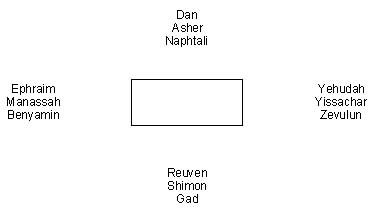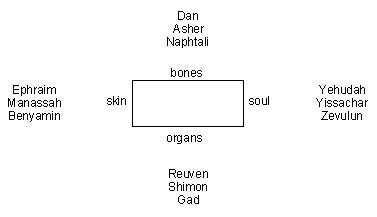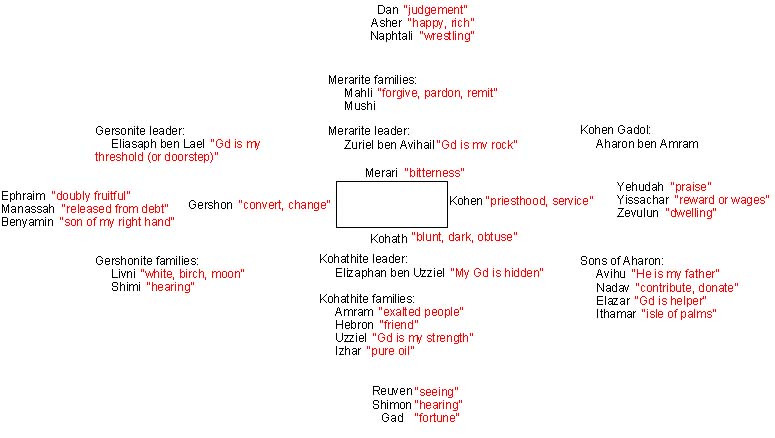
| Parshat Bemidbar (Num. 1:1-4:20) | Week of 29 Iyar, 5763 |
In the first parsha of Bemidbar is a description of the layout of the camp of Israel. On each of the four sides were three tribes: on the east was Yehudah, Yissachar, and Zevulun; on the west was Ephraim, Manassah, and Benyamin; on the north was Dan, Asher, and Naphtali; on the south was Reuven, Shimon, and Gad.

Each of the sections was headed by the banner tribe: Yehudah’s banner was the lion; Ephraim’s was the ox; Reuven was the man; Dan was the snake. These are reminiscent of Yechezkiel’s (Ezekiel) vision of the chariot’s four "chayot" (animals): the lion, the ox, the man, and in place of the snake, the eagle. Just as the chayot surrounded the chariot (the Throne of Gd), the tribes were positioned around the Mishkan (Tabernacle). It is interesting to see how this vision of Yechezkiel was actuated in the physical realm, just as the Mishkan of the wilderness was a physical copy of the Mishkan of Heaven. This picture was another method of Hashem’s imparting divine secrets into the physical world. As the chayot were the guardians of the Throne of Gd, the tribes were the guardians of the Torah and the Sanctuary of the Presence of Gd in this world.

Right around the Mishkan camped the families of the tribe of Levi, each connected with the tribes of that section. The family of Merari camped to the north with Dan, Asher, and Naphtali; the family of Kohath camped to the south with Reuven, Shimon, and Gad; the family Gershon camped to the west with Ephraim, Manassah, and Benyamin; and the family of Aharon (the Kohenim) camped to the east with Yehudah, Yissachar, and Zevulun.

Looking at the encampments, the significance of the duties of the Levite families is all the more obvious. The Mishkan can be seen as a body. The Merarites were in charge of "the planks of the Tabernacle, its bars, its pillars, its sockets and utensils, and all its accessories." (Bemidbar 2:36) These are like the bones. The Gershonites were in charge of "the Tabernacle, the Tent, its Cover, the Screen of the entrance of the Tent of the Meeting, the curtains of the Courtyard, the Screen of the entrance of the Courtyard that surrounded the Tabernacle and the Altar, and its ropes." (Bemidbar 3:25-26) These are like the skin. The Kohathites were in charge of "the Ark, the Table, the Menorah, the Altars and the sacred utensils with which they would minister, the Partition and all its accessories." (Bemidbar 3:31) These are like the organs. The Kohenim were the only ones to actually use the vessels of the Tabernacle. Their function was thus like the soul of a person.

The south was symbolic of sensual awareness of the physical realm, the hiddeness of spiritual reality. Reuven was seeing; Shimon was hearing; Gad was fortune, with a suggestion, in their choosing to stay on the east side of the Jordan, of a desire for instant gratification. The Kohathites were in charge of the items of the Mishkan similar to its organs, functional in the service of the Mishkan. These items were used for drawing the spiritual into the physical realm. Interesting, however, when transporting the Mishkan, the Kohathites were not supposed to see the items of their charge; the Kohenim had to cover them in order to protect the Kohathites from dying.
"Aharon and his sons shall finish covering the holy and all the holy utensils when the camp journeys, and then the sons of Kohath shall come to carry, so that they not touch the Sanctuary and die." – Bemidbar 4:15"Kohath" is close to the word keheh, which means "blunt, dark, obtuse." The family leader was Elizaphan, which means "My Gd is hidden." While the Mishkan was in transit, the vessels were not in their proper place for use. Therefore, because of the immense holiness of these things, they were not to be touched or even seen, a fence to prevent profaning them with some common use. This is much like the grave warning against using the Name of Gd in any profane manner. So the temptation to sensual awareness had to be controlled by the Levite family connected with the tribes most associated with physicality, and in this manner, they drew spirituality into physicality. Spiritual power used by those sensual is dangerous, destructive. This is depicted in the necessity of the Kohenim protecting the Kohathites from dying through covering, or hiding, the holy items.Hashem spoke to Moshe and Aharon, saying: "Do not let the tribe of the Kohathite families be cut off from among the Levites. Thus shall you do for them so that they shall live and not die: when they approach the Holy of Holies, Aharon and his sons shall come and assign them, every man to his work and his burden. But they shall not come and look as the holy is inserted, lest they die." -- Bemidbar 4:17-20

The north was symbolic of judgement. Dan was the judge; Asher was richness, happiness; Naphtali was a wrestling--in prayer of running and returning. The Merarites were in charge of the items of the Mishkan similar to its bones. We are told esoterically that our sins are written on our bones. Mahal, the name of one of the families of Merari, means "remit, forgive, or pardon"; on the other hand, a word related to this name, mahalah, means "sickness", which can be seen in relation to the meaning of Merari: "bitterness." While Asher implies a positive result of judgement, there is also a hint of the negative. Therefore the wrestling in prayer of Naphtali is necessary to come to forgiveness, remittance, and pardon. The leader of the Merarite families was Zuriel, which means "Gd is my rock". This is indicative of support, foundation, something hard and firm, like the structure of bones holding up the body in the same way the pillars supported the Mishkan. Just as sins are written on the bones, so, too, is Torah, with the sealed Covenant that brings the bones back to life in the resurrection. The potential of this power is so great that when a dead man’s body touched the bones of the prophet Elisha, he (the dead man) came back to life. (II Kings 13:20-21)

The west was symbolic of blessing. During the service at the beginning of each Shabbat, the Jewish people turn to welcome the light of Shekinah coming from the west. The families of Gershon were in charge of the Mishkan items that resemble skin--curtains, screens, covers, etc. The Hebrew words for skin and light are pronounced the same: "or"; only the first letter is different. Our sages say that when Adam was created his body was one of light; with the fall into sin, he was covered with skin. This covered over the spark of his true being, hiding the purpose of his creation. At the time of the Redemption, man will be elevated from this fallen state and again have a body of light. The ayin of "skin" will be transformed to the aleph of "light".
Ephraim means "doubly fruitful"; Manassah means "released from debt"; Benyamin means "son of my right hand". These names indicate three stages of redemption: this world and the world to come, salvation, and being seated at the right hand of the Father. The name of the leader of the families of Gershon, which translates into two words: "convert" and "change", was Eliasaph, which means "Gd is my threshold". We think of the threshold of Redemption, of passing through the veil (curtain) of flesh, of the Mashiach (perfect Adam) converting us into a whole new realm of being.

The east was symbolic of the physical manifestation of the fullness of Gd. The service of the Kohenim was the spirit, the soul that brings life to the body. This was the camp of the kingship and the priesthood. Yehudah was the king, whose name means "praise"; Yissachar was the Torah scholar, whose name claims a "reward"; Zevulun was the supportive merchant, establishing a "dwelling". The praise of Israel is the dwelling place of Gd and Torah study is the reward. This setting of tribal guardianship of the Torah was conducive for the Kohenim’s service to the nation as guardian of the Sanctuary.
All the potential symbolized in the other three directions is manifested in the east. The south is the receiving of the Torah, followed quickly by the sin of the golden calf, a fall into the sensual. The north is the judgement for that sin, the repentance and the forgiveness. The west is the blessing after the forgiveness that restores and brings the people into the place of sanctification, able to pass into a new place with Gd. The east is the realization of that place: the Kingdom of Mashiach. Here rules priest and king, bringing the manifestation of the fullness of Gd. In the service of the Mishkan, the laws of the Torah, and the reign of the Mashiach (anointed) king, is restoration, redemption of the nation as one holy as Gd is holy, a nation of priests. For this was, even in the days of the wilderness, a prototype of life in the Age to Come, elevating the physical realm by drawing down the things of Heaven into our world.

The east and the west are the encampments of the two manifestations of Mashiach--Yehudah and Yosef. Each faces Edom from his particular direction, in his particular way. Yaakov’s blessing of Yehudah, that he would "launder his garments in wine and his robe in the blood of grapes" (Bereshit 49:11) alludes also to the prophecy:
"Who is this coming from Edom, with sullied garments, from Bozrah? This One Who is majestic in his raiment, girded with his abundant strength?"Of Yosef it is said:
"It is I, who speaks with righteousness, abundantly able to save!"
"Why is there red on Your raiment, and why are Your garments like those of someone treading in a wine vat?"
"I alone have trodden a wine press, not a man from the nations was with Me; I trod on them in My anger and trampled them in My wrath, and their life blood spurted out on My garments, so I soiled all My garments. For a day of vengeance is in My heart, and the year of My redemption has come." -- Isaiah 63:1-4
The house of Yaakov will be a fire, the house of Yosef a flame, and the house of Esau for straw; and they will ignite them and devour them. -- Ovadiah 1:18Yehudah faces Edom in the east, and Yosef in the west. Each has his own separate, distinct task, defined by the dimensions in his group, played out through history. Yehudah was always strictly the Jewish people, defined by Torah. Yosef was dispersed among the nations and therefore assimilated and identified with them. In Ovadiah’s prophecy, he begins the verse speaking of the fire of Yaakov, which is the Truth of Torah. With a return to the Torah of his father, Yosef is able to defeat Edom of the west, with whom he had identified.
Yosef’s Mashiach (ben Yosef) defeats the spiritual Edom, while Yehudah’s Mashiach (ben David) defeats the physical Edom. Yehudah completes the work of the period called Days of Mashiach, bringing Redemption into this physical world. Ultimately, the seeming conflict between Yosef and Yehudah ends. The two sticks come together, east and west meet, bow to each other, and become one nation, restored in the heart of Israel.
| HOME | Dvar Torah |